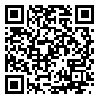Volume 31, Issue 201 (10-2021)
J Mazandaran Univ Med Sci 2021, 31(201): 59-69 |
Back to browse issues page
Download citation:
BibTeX | RIS | EndNote | Medlars | ProCite | Reference Manager | RefWorks
Send citation to:



BibTeX | RIS | EndNote | Medlars | ProCite | Reference Manager | RefWorks
Send citation to:
Zamaniyan M, Gordani N, Peivandi S, Golshani M, Khademloo M, Kalantari F et al . Effect of Saline Infusion Sonohystrography in Luteal Phase of Previous Menstrual Cycle on Pregnancy Rate in Infertile Women Undergoing Frozen-Thawed Embryo Transfer Cycle. J Mazandaran Univ Med Sci 2021; 31 (201) :59-69
URL: http://jmums.mazums.ac.ir/article-1-16758-en.html
URL: http://jmums.mazums.ac.ir/article-1-16758-en.html
Marzieh Zamaniyan 

 , Noushin Gordani
, Noushin Gordani 

 , Sepideh Peivandi
, Sepideh Peivandi 

 , Mahsa Golshani
, Mahsa Golshani 

 , Mohammad Khademloo
, Mohammad Khademloo 

 , Fatemeh Kalantari
, Fatemeh Kalantari 

 , Fatemeh Yahyapour Aghmashhadi
, Fatemeh Yahyapour Aghmashhadi 



 , Noushin Gordani
, Noushin Gordani 

 , Sepideh Peivandi
, Sepideh Peivandi 

 , Mahsa Golshani
, Mahsa Golshani 

 , Mohammad Khademloo
, Mohammad Khademloo 

 , Fatemeh Kalantari
, Fatemeh Kalantari 

 , Fatemeh Yahyapour Aghmashhadi
, Fatemeh Yahyapour Aghmashhadi 

Abstract: (1037 Views)
Background and purpose: One of the problems of in vitro fertilization (IVF) cycles is recurrent failure of implantation. The present study aimed to investigate the effect of intrauterine saline infusion in luteal phase of previous menstrual cycle on occurrence of pregnancy in infertile patients undergoing frozen-thawed embryo transfer.
Materials and methods: This clinical trial was conducted in 70 infertile women attending the infertility center in Sari Imam Khomeini Hospital who were undergoing frozen-thawed embryo transfer in 2020. The participants were randomly divided into an intervention group and a control group (n= 35 per group) using random number table. In intervention group, intrauterine injection of saline with ultrasound guidance was performed on day 21 of previous menstrual cycle, while the control group received no intervention. Pregnancy outcomes were compared between the two groups. Data analysis was performed using Chi-square and t-test.
Results: The intervention group and control group were found to be significantly different in rate of clinical pregnancy (6.5%, 28.1%) (P=0.003) and live birth (6.5%, 28.1%), respectively (P=0.02).
Conclusion: In this study, saline infusion sonohysterography did not have positive effect on clinical pregnancy and live birth, which could be due to small sample size, performing the procedure on day 21 of cycle, or ineffectiveness of this method in causing inflammation following scratches compared to conventional methods. Further molecular and cellular studies are needed to compare the effect of these methods on increasing the level of inflammatory factors.
(Clinical Trials Registry Number: IRCT20160815029374N8)
Materials and methods: This clinical trial was conducted in 70 infertile women attending the infertility center in Sari Imam Khomeini Hospital who were undergoing frozen-thawed embryo transfer in 2020. The participants were randomly divided into an intervention group and a control group (n= 35 per group) using random number table. In intervention group, intrauterine injection of saline with ultrasound guidance was performed on day 21 of previous menstrual cycle, while the control group received no intervention. Pregnancy outcomes were compared between the two groups. Data analysis was performed using Chi-square and t-test.
Results: The intervention group and control group were found to be significantly different in rate of clinical pregnancy (6.5%, 28.1%) (P=0.003) and live birth (6.5%, 28.1%), respectively (P=0.02).
Conclusion: In this study, saline infusion sonohysterography did not have positive effect on clinical pregnancy and live birth, which could be due to small sample size, performing the procedure on day 21 of cycle, or ineffectiveness of this method in causing inflammation following scratches compared to conventional methods. Further molecular and cellular studies are needed to compare the effect of these methods on increasing the level of inflammatory factors.
(Clinical Trials Registry Number: IRCT20160815029374N8)
Type of Study: Research(Original) |
Subject:
Gynecology and Infertility
Send email to the article author
| Rights and permissions | |
 |
This work is licensed under a Creative Commons Attribution-NonCommercial 4.0 International License. |





